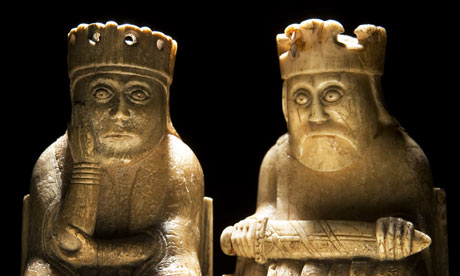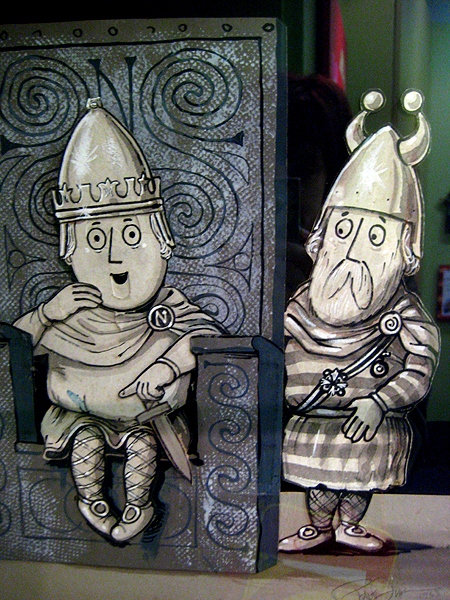Stokesley on the edge of the North York Moors is a delightful market town. It has a little river that runs through it on which the ducks paddle searching for crusts of bread. There are butchers and bakers and quite possibly candle-stick makers, banks, hairdressers, newsagents, grocers, boutique clothing outlets, and stationers.
You can happily walk up one side of the street and down the other, popping into a choice of churches, cafes, pubs and restaurants and (if you are like my brother-in-law Mr Smartypants) doffing your cloth cap at 'my good neighbour' spoken in a peculiar vernacular of Yorkadian (Yorkshire/Canadian). It doesn't matter what you do out in the big blue yonder, when you are in Stokesley all is well with the world.
And then the fair comes to town.
.jpg) The Stokesley Fair transforms a sleepy village hamlet into a pulsating, flashing street of screams and vomit. The aromas are diesel fumes, fat and sugar as machines with names like Extreme, The Edge, and Over the Top rotate and revolve in three different ways. Airbrushed pictures of tropical palms cannot mask the northern brick red roofs as the half moon bravely tries to shed scenic light above a terrace.
The Stokesley Fair transforms a sleepy village hamlet into a pulsating, flashing street of screams and vomit. The aromas are diesel fumes, fat and sugar as machines with names like Extreme, The Edge, and Over the Top rotate and revolve in three different ways. Airbrushed pictures of tropical palms cannot mask the northern brick red roofs as the half moon bravely tries to shed scenic light above a terrace.Nothing has changed in the cheese factor of the fair's music: Bonnie Tyler and Phil Collins boom out against the Black Eyed Peas and some bint urging us to 'take it off' - not in North Yorkshire where it's cold and raining, surely. Klaxons and computer-generated enthusiasm fill the air with audio pollution as King Frog, Crazy Frog, Crazy Circus and the bumper cars vie for attention with not altogether friendly competition.
.jpg) You can win goldfish at the hoopla or throw or shoot things for a Spongebob Squarepants or Toy Story prize - every time! Even the rewards are passe and desperate. 'Are you ready?' 'Yeah, baby!' Force yourself to be jolly - choose your weapon of transatlantic confection: wilting bags of pallid candy-floss; sizzlers; 1/4 burgers; roast pork 'American style'.
You can win goldfish at the hoopla or throw or shoot things for a Spongebob Squarepants or Toy Story prize - every time! Even the rewards are passe and desperate. 'Are you ready?' 'Yeah, baby!' Force yourself to be jolly - choose your weapon of transatlantic confection: wilting bags of pallid candy-floss; sizzlers; 1/4 burgers; roast pork 'American style'..jpg) Children are primed for an adulthood of brief excitement and lengthy disappointment. Their miniature rides mimic those of the adults and despite the tame tea pots and the mini wheel twinkling fairy-like through the trees, they ride the energy storm with their hands in the air like they just don't care and squeal with the best (and worst) of them. Gypsies Rose, Lee and Bothwell can predict their future from the caravan or motor home, but teenage pregnancy, benefit dependency and spiritual unfulfilment isn't tricky to foretell.
Children are primed for an adulthood of brief excitement and lengthy disappointment. Their miniature rides mimic those of the adults and despite the tame tea pots and the mini wheel twinkling fairy-like through the trees, they ride the energy storm with their hands in the air like they just don't care and squeal with the best (and worst) of them. Gypsies Rose, Lee and Bothwell can predict their future from the caravan or motor home, but teenage pregnancy, benefit dependency and spiritual unfulfilment isn't tricky to foretell..jpg) Giant teddies bear rictus grins and dead eyes. Theatre may be shabby back stage but out front it is magic. The fierce tawdriness of this fair is all pervasive and I doubt any are deceived. Down this end of town they play Only the Lonely and try to ignore the poignancy. The Captain Cook Brewery seems a much better proposition and we drink our way along the bar. Sunset (4%) - a smooth, nutty, session ale; Slipway (4.2%) - a dry, hoppy ale with a touch of citrus tang and a lingering bitterness; Endeavour (4.5%) - a darker session beer with a clean palate, malty flavour and no bitter aftertaste. 'Almost too plain'; Black Porter (4.3%) - like velvet with sweet notes of licorice and chocolate.
Giant teddies bear rictus grins and dead eyes. Theatre may be shabby back stage but out front it is magic. The fierce tawdriness of this fair is all pervasive and I doubt any are deceived. Down this end of town they play Only the Lonely and try to ignore the poignancy. The Captain Cook Brewery seems a much better proposition and we drink our way along the bar. Sunset (4%) - a smooth, nutty, session ale; Slipway (4.2%) - a dry, hoppy ale with a touch of citrus tang and a lingering bitterness; Endeavour (4.5%) - a darker session beer with a clean palate, malty flavour and no bitter aftertaste. 'Almost too plain'; Black Porter (4.3%) - like velvet with sweet notes of licorice and chocolate..JPG)
.JPG)
.JPG)
.jpg)
.jpg)
.jpg)
.jpg)
.jpg)



